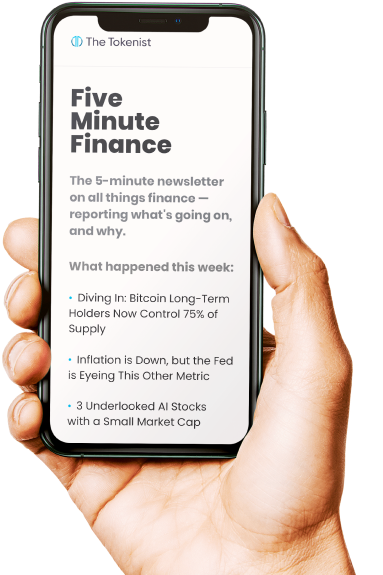
Small Caps are Trading at Steep Discount; These Three Can Be Solid Buys
On November 1st, the Federal Open Market Committee (FOMC) issued a second interest rate pause. After a consecutive series of 11 rate hikes, the federal funds rate now appears to be stuck in July’s range of 5.25% – 5.50%. The market has reacted accordingly since.
Within two days, the US benchmark for small-cap stocks, Russell 2000 (RUT), went up 7%. The index was followed by accompanying exchange-traded funds, the iShares Core S&P Small-Cap ETF ( IJR), and the SPDR Portfolio S&P 600 Small-Cap ETF (SPSM).
Both ETFs have gained 5% over the last five days. This makes sense as smaller companies rely on debt to finance growth, lacking the deep pockets of large-cap companies. The prospect of interest rate hikes being halted means that capital expenses can be accounted for.
Big Macro Picture for Small Cap Stocks
At the same time, the USG has to pay higher interest rates on its monetized debt, such as Treasury securities. The Congressional Budget Office (CBO) noted a 33% increase on Federal debt cost from FY2022, an unsustainable uptick from $177 billion to $711 billion.
This represents greater budget expenditure than is allocated for education, transportation, or veterans’ benefits. Even worse, this rising debt cost comes when the federal government’s budget deficit is projected to be record high (outside the post-lockdown era) at $1.7 trillion for FY2023.
In the big picture, interest rates will have to come down, presenting an opportunity for small-cap stocks to break out from the discount zone. Keeping in mind that small stocks are more volatile and subject to insider trading, just as altcoins, which small-cap stocks have the capacity for double-digit breakouts?
Join our Telegram group and never miss a breaking digital asset story.
ACM Research (NASDAQ: $ACMR)
Year-to-date, this semiconductor supplier has gained +55%, owing to its critical niche. The company supplies wet processing technology to remove contaminants from chip wafer surfaces before etching and deposition.
All advanced electronics undergo wet processing as a part of semiconductor manufacturing. In this capacity, ACMR stock is second out of IBD’s 27 stocks for the semiconductor equipment industry group. With generative AI services unlikely to decline, ACM services should mirror the demand.
Year-over-year, ACM Research more than doubled its net income from a year ago, at $59.6 million, with a quarterly 26% uptick in sales. In Q3’23, the company beat Zacks consensus of $0.35 earnings-per-share (EPS) at $0.57 EPS. Compared to the year-ago quarter, ACM Research shipments increased 31%. Even its gross margin improved from 46.3% to 50.9%.
Based on six analyst inputs pulled by Nasdaq, ACMR stock is a “strong buy.” The average ACMR price target is $24.4 vs current $15 per share. The high estimate is $32, while the low forecast is $18.2, substantially above the present price.
Digi International (NASDAQ: $DGII)
This Minnesota-based company occupies a midway position in the fourth industrial revolution. It provides both Internet of Things (IoT) connectivity devices, such as gateways and routers, alongside software suites to manage machine-to-machine (M2M) products.
Digi’s demand is poised for heavy growth in smart city applications alone. By 2030, the smart cities market by component (hardware, software, service) will reach $6 trillion from $648.36 billion in 2020.
In Q3 2023, Digi beat the EPS consensus of $0.41 at $0.44 while also beating the revenue estimate of $108.75 million at $112.24 million. The next quarterly earnings report is scheduled for November 9th.
Based on six analyst inputs pulled by Nasdaq, DGII stock is a “strong buy.” The average DGII price target is $50 vs the current $24.78 per share.
IBEX Holdings (NASDAQ: $IBEX)
Of the three stocks, IBEX has gained the most in the last month, at +8.14% performance. IBEX helps other companies leverage their brand identity, known as Business Process Outsourcing (BPO). This ranges from loyalty programs to customer lifestyle experiences to event management.
Likewise, IBEX provides end-to-end solutions for developing and executing digital marketing campaigns. Over a year, in Q3, the company increased revenue from $123.5 million to $131.9 million, increasing its net income margin by 8.9%. IBEX beat its EPS estimate of $0.31 at $0.57.
Based on five analysts pulled by Nasdaq, IBEX stock is a “strong buy.” The average IBEX price target is $20 vs the current $17.16 per share. The high estimate is $25 vs the low estimate at the present price level of $17. Although IBEX didn’t guide Q4’23, it expects further growth in its BPO 2.0 Digital-First and Analytics segment.
Is your portfolio exposed to growth stocks more than to blue chip stocks? Let us know in the comments below.




